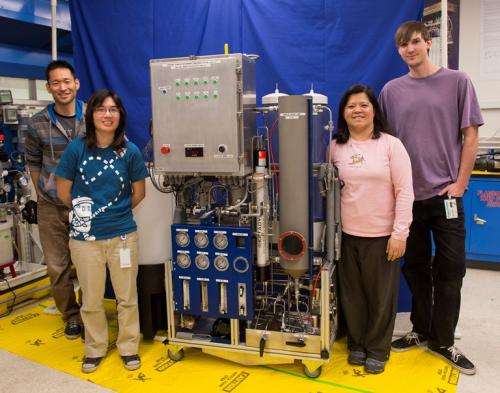NASA targets water recycling system for rapid development

Water is one of the most crucial provisions an astronaut will need to live and work in space. Whether orbiting Earth, working at a lunar base or traveling to Mars, astronauts must save as much water as possible. That's why NASA has targeted its water recycling technology for rapid development.
On the International Space Station, each crewmember is allocated about two liters of water daily. Such conservation means the crew must stretch the ration by collecting, cleaning and reusing wastewater, condensate in the air and urine. For future deep space missions, astronauts will need even greater amounts of water.
To help them save this precious commodity, research engineers at NASA's Ames Research Center, Moffett Field, Calif., are following several different but complementary avenues to develop dependable ways of recycling water.
"We are very excited about the advanced water processor technology development work being done at NASA Ames," said Steve Gaddis, manager for NASA's Game Changing Development Program at the agency's Langley Research Center in Hampton, Va. " We're anticipating a system capable of treating all exploration wastewater—including hygiene and laundry—at a recovery rate of greater than 95 percent."
The most recent development of NASA's water recycling system is the Alternative Water Processor currently being developed by NASA's Next Generation Life Support Project, under the Game Changing Development Program. The water processor has a membrane-aerated bioreactor to destroy organic contaminate and a forward osmosis secondary treatment system to remove dissolved solids.
Construction of the first generation forward osmosis secondary treatment system (FOST) was recently completed at NASA Ames. The system was recently shipped to NASA's Johnson Space Center in Houston to undergo integrated testing with the membrane-aerated bioreactor, which was designed by Texas Tech University, Lubbock and constructed by NASA Johnson.
New design concepts continue to drive the evolution of this important technology. Thanks to an agency initiative called "Replacement by Renovation," NASA Ames was able to construct Sustainability Base, one of the greenest buildings in the federal government.
As part of Sustainability Base's design, NASA researchers installed a new forward osmosis water recovery system in the building, this time for use here on Earth. This system, in combination with other water-saving technologies integrated into the building, is expected to reduce water consumption in Sustainability Base by more than 90 percent.
The recently delivered forward osmosis system is a smaller version of the one in Sustainability Base. It is sized to support a crew of four on a long-duration space flight mission.
The forward osmosis is NASA's next generation water recycling technique. It will help reduce the cost of human space flight, as it increases its own reliability. This evolving technology also is starting to drive innovation and advancements in the state-of-the-art terrestrial water recycling.
"Inside the water recovery system is an evolving set of technologies with great promise," said Michael Flynn, a research engineer at NASA Ames. "Ultimately, these systems will continue to evolve and become increasingly more complex, integrated and smaller."
Provided by NASA
















